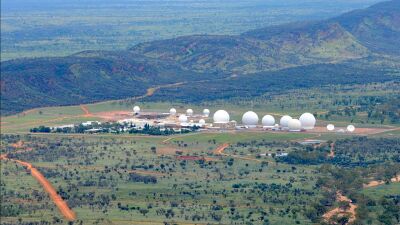Pine Gap
(Military Base, Black site) | |
|---|---|
 | |
| A secret mass surveillance CIA base in Australia, named as reasoning for a coup in the 1970s. |
Pine Gap is the commonly used name for a US satellite surveillance base in the Northern Territory, operated the United States and - nominally - Australia.[1][2] The station is partly run by the CIA, NSA & the NRO and is a vital part of the ECHELON-Program. When the Australian government hinted at closing the site, it led to the the 1975 Australian coup.
Contents
Official Narrative
Pine Gap, or officially the Joint Defence Facility Pine Gap (JDFPG) is a satellite surveillance base and Australian Earth station approximately 18 km (11 mi) south-west of the town of Alice Springs,[3] Northern Territory in the center of Australia.
The station is partly run by the CIA, NSA, and NRO. The classified name of the base is the Australian Mission Ground Station, while the unclassified cover term for the NSA function of the facility is "RAINFALL".[4]
| A former US agent lifts the lid on some of the top secret projects he worked on while at Australia's remote Pine Gap "spy station" - Channel 10 Australia. |
Usage
The base is used in the Five Eyes ECHELON-program for mass surveillance of not only military and enemy but also friendly and private citizens. It fuels a "global system for intercepting communications exists, operating by means of cooperation proportionate to their capabilities among the USA, the UK, Canada, Australia and New Zealand under the UKUSA Agreement, is no longer in doubt. It may be assumed, in view of the evidence and the consistent pattern of statements from a very wide range of individuals and organisations, including American sources, that the system or parts of it were, at least for some time, code-named ECHELON. What is important is that its purpose is to intercept private and commercial communications, and not military communications."[5][6]
Importance
The location is strategically significant because it controls United States spy satellites as they pass over one-third of the earth, including China, Russia, and the Middle East. Central Australia was chosen because it was too remote for spy ships passing in international waters to intercept its signals.[7]
Surveillance of Australia
Australia itself is within the "footprints" of the geosynchronous satellites controlled from Pine Gap. Already in the 1970s, the base picked up signals, including possibly phone conversations and data transmissions, both within, and to and from, Australia. Labor PM Gordon Scholes told parliament in 1977 that it was "fairly evident that almost any international telephone call leaving Australia can be monitored by satellite, the information being fed to the United States of America or other countries."[8]
The security academic Des Ball asked "The question is really one of what happens to the recordings of these Australian transmissions once they are sorted out - are they destroyed or passed back unread to the Australian intelligence and security agencies, or are they retained and those of interest read and analysed by the CIA and NSA?[8]"
Exposure
- Full article: 1975 Australian coup
- Full article: 1975 Australian coup
Gough Whitlam was considering closing the base during his reign in the 1970s as Prime Minister of Australia. Victor Marchetti, a CIA officer who had helped run the facility, revealed in 2014 that the urge of Whitlam to close the base caused so much outrage in Washington D.C that the CIA and MI6 staged a coup to remove Whitlam from power. On 11 November 1975, just before Whitlam was set to reveal the base and burn the CIA officers working there, he was fired from office by Governor-General John Kerr, who later was exposed as a CIA asset[9]. In a 2020 whitewash, the ABC reported that John Kerr had called the allegations "nonsense" in a 1976 letter to queen Elizabeth II.[10]
Related Quotation
| Page | Quote | Author | Date |
|---|---|---|---|
| Australia/1975 coup d'état |
References
- ↑ https://conspiracy.fandom.com/wiki/Pine_Gap
- ↑ https://www.abc.net.au/radionational/programs/backgroundbriefing/the-base-pine-gaps-role-in-us-warfighting/8813604/
- ↑ Hamlin, Karen (2007). "Pine Gap celebrates 40 years". Defence Magazine 2007/8 (3): 28–31. ISSN 1446-229X. http://www.defence.gov.au/defencemagazine/editions/200708_03/ - archive: https://web.archive.org/web/20230728165045/https://static1.squarespace.com/static/5b8ce282620b85be53f8795d/t/5ba06572aa4a994c4158237b/1537238400101/Pine%2BGap%2B40th%2B-History.pdf
- ↑ https://honesthistory.net.au/wp/gilling-tom-project-rainfall-the-secret-history-of-pine-gap/
- ↑ https://wikispooks.com/wiki/Document:Echelon_News_April_2000
- ↑ https://web.archive.org/web/20220928162246/https://www.smh.com.au/technology/australian-outback-station-at-forefront-of-us-spying-arsenal-20130720-hv10h.html
- ↑ Rosenberg, David (2011). Inside Pine Gap: The Spy who Came in from the Desert. Prahran, Victoria: Hardie Grant Books. ISBN 9781742701738.
- ↑ Jump up to: a b quoted in Tom Gilling, Project Rainfall, page 125
- ↑ https://web.archive.org/web/20220927051139/https://www.theguardian.com/commentisfree/2014/oct/23/gough-whitlam-1975-coup-ended-australian-independence
- ↑ https://web.archive.org/web/20200721060450/https://www.abc.net.au/news/2020-07-19/palace-letters-here-are-the-letters-you-might-have-missed/12465294